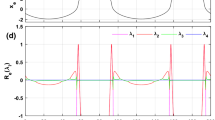Abstract
We find that the fractional-order Hindmarsh-Rose model neuron demonstrates various types of firing behavior as a function of the fractional order in this study. There exists a clear difference in the bifurcation diagram between the fractional-order Hindmarsh-Rose model and the corresponding integer-order model even though the neuron undergoes a Hopf bifurcation to oscillation and then starts a period-doubling cascade to chaos with the decrease of the externally applied current. Interestingly, the discharge frequency of the fractional-order Hindmarsh-Rose model neuron is greater than that of the integer-order counterpart irrespective of whether the neuron exhibits periodic or chaotic firing. Then we demonstrate that the firing behavior of the fractional-order Hindmarsh-Rose model neuron has a higher complexity than that of the integer-order counterpart. Also, the synchronization phenomenon is investigated in the network of two electrically coupled fractional-order model neurons. We show that the synchronization rate increases as the fractional order decreases.
Similar content being viewed by others
References
Hodgkin A, Huxley A. A quantitative description of membrane current and its application to conduction and excitation in nerve. J Physiol, 1952, 117: 500–544
Magin R. Fractional Calculus in Bioengineering. Begell House, 2004
Auastasio T. The fractional-order dynamics of brainstem vestibule-oculomotor neurons. Biol Cybern, 1994, 72: 69–79
Lundstrom B N, Higgs M H, Spain W J, et al. Fractional differentiation by neocortical pyramidal neurons. J Nature Neuroscience, 2008, 11: 1335–1342.
Sabatier J, Agrawal O P, Tenreiro Machado J A. Advances in Fractional Calculus Theoretical Developments and Applications in Physics and Engineering. Springer, 2007
Wang Q Y, Shi X, Lu Q S. Synchronization Dynamics in The Coupled System of Neurons. Beijing: Science Press, 2008
Shen Y, Hou Z H, Xin H W. Transition to burst synchronization in coupled neuron networks. Phys Rev E, 2008, 77: 0319201.
Meng P, Wang Q Y, Lu Q S. Bursting synchronization dynamics of pancreatic β-cells with electrical and chemical coupling. Cognitive Neurodynamics, 2013, 7: 197–212
Wang H X, Wang Q Y, Lu Q S, et al. Equilibrium analysis and phase synchronization of two coupled HR neurons with gap junction. Cognitive Neurodynamics, 2013, 7: 121–131.
Pinto R D, Varona P, Volkovskii A R, et al. Synchronous behavior of two coupled electronic neurons. Phys Rev E, 2002, 62: 2644–1656
Shuai J W, Durand D M. Phase synchronization in two coupled chaotic neurons. Physics Letters A, 1999, 264: 289–297
Dhamala M, Viktor K J, Ding M Z. Transitions to synchrony in coupled bursting neurons. Phys Rev Lett, 2004, 2: 028101
Podlubny I. Fractional differential Equation. Academic Press, 1999.
Cafagna D, Grassi G. An effective method for detecting chaos in fractional-order systems. Int J Bifurcat Chaos, 2010, 20: 669–678
Matignon D. Stability results for fractional differential equations with application to control processing. In: IMACS, IEEE-SMC, Lille, France, 1996
Ahmed E, El-Sayed A M A, El-Saka H A A. Equilibrium points, stability and numerical solutions of fractional-order predator-prey and rabies models. J Math Analysis Appl. 2007, 325: 542–553
Li C P, Zhang F R. A survey on the stability of fractional differential equations, Eur. Phys. J. Special Topics, 2011, 193: 27–47.
Shilnikov A, Kolomiets M. Methods of the qualitative theory for the Hindmarsh-Rose model: A case study. International Journal of Bifurcation and Chaos, 2008, 18: 2141–2168
Huang S F, Zhang J Q, Ding S J. State-to-state transitions in a Hindmarsh-Rose neuron system. Chin Phys Lett, 2009, 26: 050502
Duan L X, Fan D G, Lu Q S, Hopf bifurcation and bursting synchronization in an excitable systems with chemical delayed coupling. Cognitive Neurodynamics, 2013, 7: 341–349
Li C P, Peng G J. Chaos in Chen’s system with a fractional order. Chaos, Solitons & Fractals, 2004, 22: 443–450
Pincus S M. Approximate entropy as a measure of system complexity. PNAS, 1991, 88: 2297–2301
Grassberger P, Procaccia I. Measuring the strangeness of strange attractors. Physica D, 1983, 9: 189–208.
Zhang Y J, Li M S, Lu Q S. Firing Patterns and the Effect of Time-Delay Coupling on Synchronization of Two Coupled Chaotic ML Neurons. Journal of Dynamics and Control, 2009, 7: 19–23
Rosenblum M G, Pikovsky A S, Kurths J. From Phase to Lag Synchronization in Coupled Chaotic Oscillators. Phys Rev Lett 1997, 78: 4193–4196
Pecora L M, Carroll T L. Master stability functions for synchronized coupled systems
Author information
Authors and Affiliations
Corresponding author
Rights and permissions
About this article
Cite this article
Xie, Y., Kang, Y., Liu, Y. et al. Firing properties and synchronization rate in fractional-order Hindmarsh-Rose model neurons. Sci. China Technol. Sci. 57, 914–922 (2014). https://doi.org/10.1007/s11431-014-5531-3
Received:
Accepted:
Published:
Issue Date:
DOI: https://doi.org/10.1007/s11431-014-5531-3




